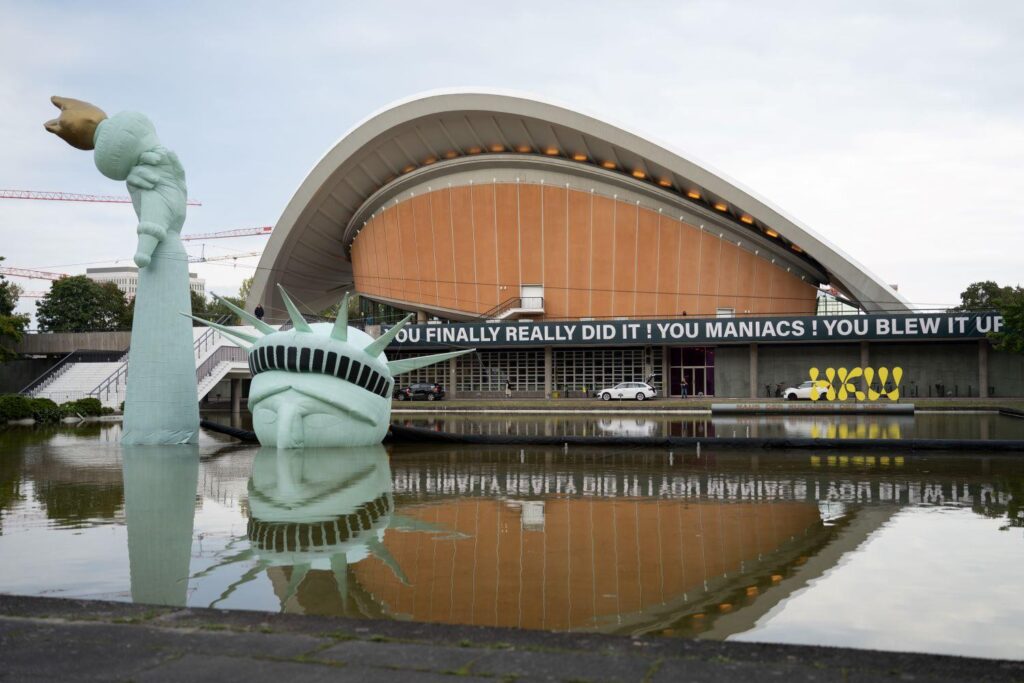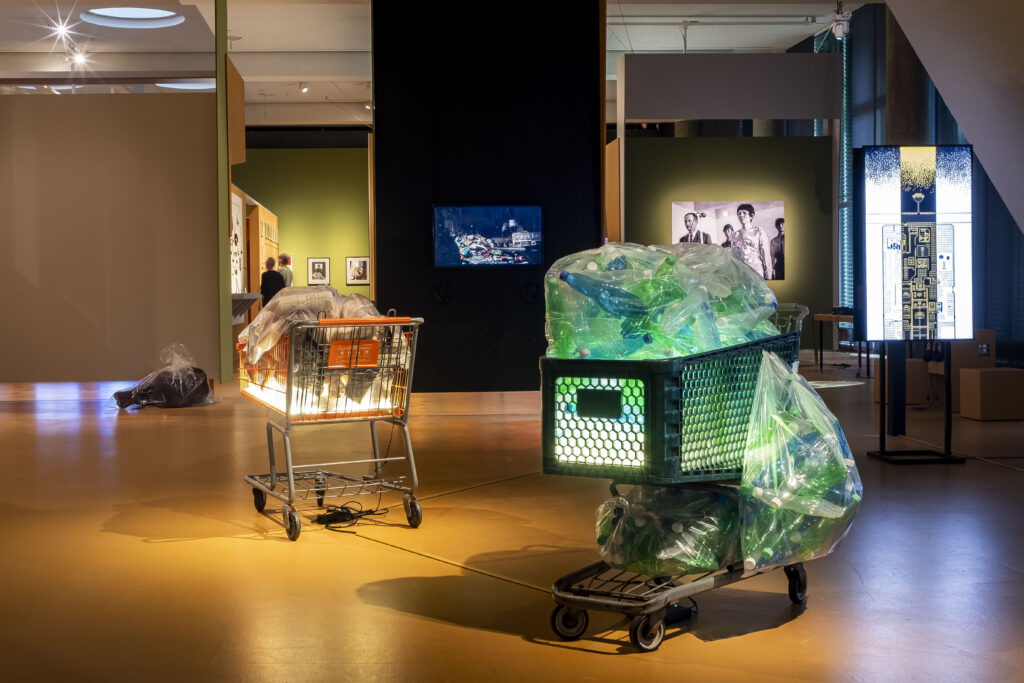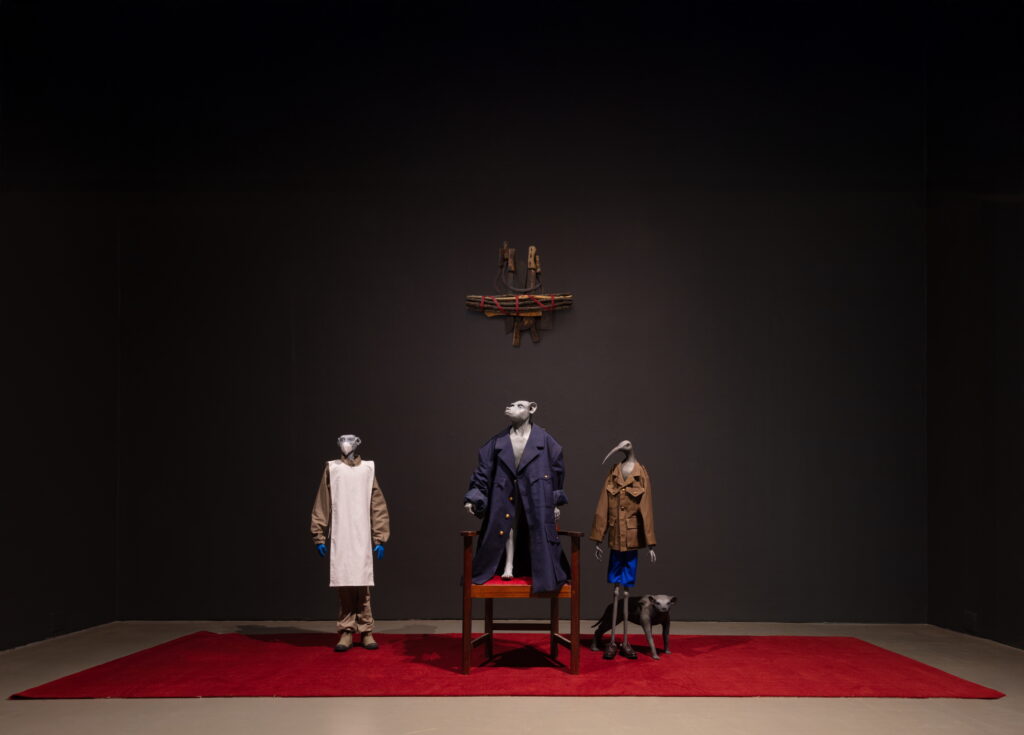
foto: Lenny Rothenberg
No matter how many times you visit the Haus der Kulturen der Welt (House of World Cultures), it never fails to impress: a futuristic-looking building crowned with its enormous curved roof, an effect amplified by the reflection in the ponds at the entrance. Once inside, however, you have to make a mental switch from 1957 to 2025. The first thing that greets you is the bookshop, which now serves as the calling card of today’s HKW — more reminiscent of university reading lists in political science and the humanities than the usual assortment of coffee-table books one expects from the likes of Walter König’s museum shops.
I had come for the exhibition Global Fascisms, not for The Possibility of Irrationality, a show to the right of the entrance created by Jan Böhmermann & Gruppe Royale, who took over Das Haus for three weeks. When the exhibition closed on 19 October, the counter had reached 30,000 visitors — presumably mostly Böhmermann fans — all willing to pay the price of surrendering their mobile phones and cameras at the entrance.
Böhmermann, known for his late-night show ZDF Magazin Royale, now in its fifth year, is often described as Germany’s answer to Arjen Lubach (or the other way around) — a satirist who, through this exhibition, seeks to demonstrate how politicians, by endlessly invoking reason (“Vernunft”), lose sight of or deliberately obscure the irrational. His late-night show frequently dissects the deceptions hidden within dialectical language. By requiring visitors to hand over their devices, Böhmermann and his group kept social media outside during the visit. In return, his curious fans were treated to familiar paraphernalia and a rare glimpse into two decades of his legal correspondence — an archive encompassing approximately 86,000 A4 sheets relating to 100 criminal and civil lawsuits, and warnings, that were partially on display at the HKW.

The X factor of a title
I kept my phone in my pocket and picked up my ticket for Global Fascisms, complete with its accompanying handbook.
The title alone has a certain ring to me. It sounds bold, intriguing, and at the same time distracts — slightly — from Germany’s omnipresent Nazi past, which lingers everywhere in Berlin. Yet the exhibition’s opening works by Hannah Höch, Maria Lassnig, and Martin Kippenberger keep the visitor momentarily grounded in Germany [1]. A good start! For anyone familiar with exhibition history, the title recalls landmark shows such as Global Conceptualism: Points of Origin, 1950s–1980s (1999), The Global Contemporary and the Rise of New Art Worlds (2013), and Global Activism (2015).
The title certainly rolls off the tongue — in fact, more easily than Anti-Fascist Church, a twelve-hour manifestation recently held in a Rotterdam church by artists Jeanne van Heeswijk and Jonas Staal, for those already converted to antifascism. Unlike the Berlin show, their title leaves no room for ambiguity. The Berlin title, however, is quite problematic — indirect as it is, with marketing clearly having had the final say. Why indirect? Because the underlying assumption is that everyone understands the show as far from an attempt to catalogue all current forms of fascism worldwide. Art has the ultimate final say.
[1] In Jörg Heiser’s review (https://www.e-flux.com/criticism/6782324/global-fascisms ) one can find a good description. I share his largely critical concerns.

Jane Alexander, Council with emblem (2025), Monitor (2023); Representative in law enforcement jacket, (2006,14), Bird in Step Out tunic (2024); Beast (2003); Emblem (2025). Courtesy Jane Alexander.
The exhibition takes us around the world through works of art — though not always to the most hospitable places. What we see are expressions of repressive politics, particularly violent ones, rendered in diverse forms: personal or detached, confrontational or humorous, allegorical or undisguised, documentary or using more traditionally artistic means. Yet fundamental questions — such as why the label fascism — remain unanswered.
By implicitly reproducing the rhetoric of us (the antifascists) versus them (the far-right extremists) — and by upholding fascism as merely a dangerous ideology to be opposed — the exhibition ends up reaffirming familiar views. Visitors can hardly escape this framing, especially since contextual information about the works, and the places and times they emerged from, is largely absent.
I had expected the thread to be picked up that HKW director Soh Bejeng Ndikung had laid down in his introduction to the handbook. Here, he unsettles the visitor (and reader) with two quotations: one by Patrick Chamoiseau, describing contemporary fascisms as mutations or returns of grand narratives; and another, harder to reconcile, from Michel Foucault: “Fascism is in each of us.”
Personally, I would have preferred the dialectic that happened to be central to the neighboring exhibition at the HKW — but then framed through Max Horkheimer’s analysis of fascism, or the concept of contradiction as noted by Umberto Eco, or the precise clarifications offered by Hannah Arendt, which might help us better grasp the treacherous strategies leading to various fascisms.
Who knows — you might find a useful answer in Eco’s “How to Spot a Fascist”, the smallest coffee-table book(let), easy to find in Berlin at Walter König’s bookstore at the Hamburger Bahnhof, next to the cash register, or else in the — globally accessible — e-book edition.